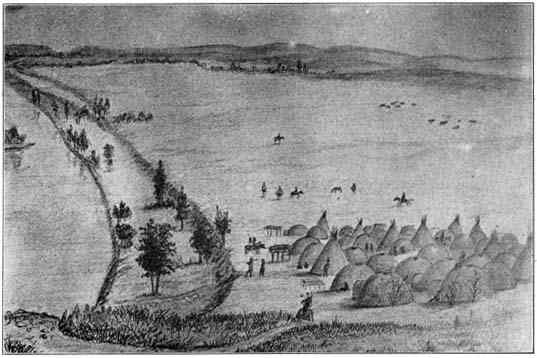|
CHAPTER III
Typical Indian Tepee Three distinct Indian peoples,--the Pawnee, the Sioux and the Algonquin,--differing in language, customs, and traditions, were found in Nebraska by the earliest white explorers. |
The Pawnees were in almost constant warfare with all of their neighbors. The Sioux, Cheyenne, Crow, Arapahoe, Comanche. Kiowa, Usage tribes--each and all sharpened their knives on a common whetstone of hatred to hunt the Pawnee. Was it because of radical difference of blood and speech or because the more savage, wilder tribes hold a natural animosity toward those who are passing out of the hunting into the agricultural stage? Tribes that have begun to make permanent settlements and cultivate the soil offer more incentive to their wild neighbors in the way of booty ,and are always in danger of extermination until they form communities strong enough to reduce the wild men to submission. So we find the Omahas, Otoes and Poncas--all of them really Sioux Indians as both language 
Pawnee Indian Village on Platte River Near Fremont,
Sketch by Simmons, 1856. and tradition establish--but Sioux who had begun to farm and settle down, living at the time the historical period begins along the Missouri river under the protection of the Pawnees, with the latter nation acting as a buffer state between them and their own wild relatives--the Oglala and Brule Sioux. Besides these little tribes the only people in the trans-Missouri region with whom the Pawnees were on terms of peace and commerce were the Wichitas, of Kansas, and the Aricaras and Mandans of Dakota,--the first two being their own kinsmen speaking dialects of the same language. |
 |
 |
 |
 |
|
@ 2002 for the NEGenWeb Project by Pam Rietsch, Ted & Carole Miller |
|||
